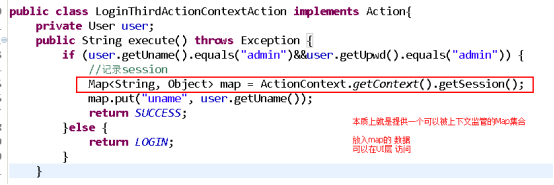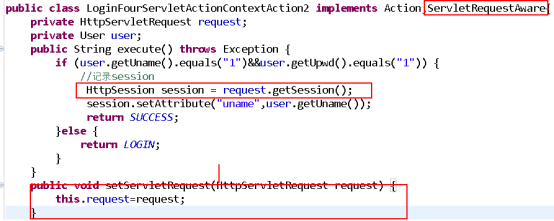1.使用Struts 2 开发程序的基本步骤
加载Struts2 类库
配置web.xml文件
开发视图层页面
开发控制层Action
配置struts.xml文件
部署、运行项目
步骤1: 配置web.xml文件
<filter>
<filter-name>struts2</filter-name>
<filter-class>org.apache.struts2.dispatcher.ng.filter.StrutsPrepareAndExecuteFilter</filter-class>
</filter>
<filter-mapping>
<filter-name>struts2</filter-name>
<!-- 拦截所有的action -->
<url-pattern>/*</url-pattern>
</filter-mapping>
步骤2:在src下创建名称为struts.xml的配置文件
<?xml version="1.0" encoding="UTF-8" ?>
<!DOCTYPE struts PUBLIC
"-//Apache Software Foundation//DTD Struts Configuration 2.3//EN"
"http://struts.apache.org/dtds/struts-2.3.dtd">
<struts>
<!-- 配置文件中只要添加以下配置,那么以后修改配置文件不用重启tomcat -->
<constant name="struts.devMode" value="true" />
<package name="default" namespace="/" extends="struts-default">
<!-- 第一个action的例子 -->
<action name="helloWorld" class="cn.happy.action.HelloWorldAction">
<result name="success">
index.jsp
</result>
</action>
<!-- 登录的action -->
</package>
<!-- Add packages here -->
</struts>
步骤3:编写HelloWorldAction
package cn.happy.action;
import com.opensymphony.xwork2.Action;
public class HelloWorldAction implements Action{
private String name ;
private String message;
public String execute() throws Exception {
setMessage("Hello"+getName());
return "success";
}
}
步骤4:创建index.jsp页面
<div>
<h1>
<!--显示Struts Action中message的属性内容-->
<s:property value="message"/>
</h1>
</div>
<div>
<form action="helloWorld.action" method="post">
请输入您的姓名:
<input name="name" type="text" />
<input type="submit" value="提交" />
</form>
</div>
步骤5:通过浏览器访问
2.登录案例强化:关于自动装配问题
在开发中,通常会以JavaBean方式保存数据。所以可以有如下写法
Action类

Jsp页面

3.Struts2 访问servlet API
在servlet中可以通过servlet API来获取Session,在Struts中如何获取Session呢?
解析:将用户名放入session 两种方案
1. 与Servlet API解耦的访问方式
--->01.使用ActionContext类获取ServletAPI对象对应的Map对象
--->02.Struts2向Action注入ServletAPI对象对应的Map对象
2. 与Servlet API耦合的访问方式
解耦方式:
方案一: 对Servlet API进行封装 ,借助ActionContext
提供了三个Map对象访问request、session、application作用域
通过ActionContext类获取这三个Map对象
Object get("request")
Map getSession()
Map getApplication()
案例:登录成功后,记录用户名到Session中,登录失败,跳会登录页面
步骤一:书写Action

方案二:向Action中注入ServletAPI对象对应的Map对象
步骤一:书写Action

耦合方式:
方式一:通过ActionContext的子类ServletActionContext实现

方式二:向Action实例注入Servlet API对象

02.在Struts中如何保存登陆用户名 ,用Session机制
解析:在Servlet中如何获取到Session对象?
----->request.getSession()
在Struts中如何获取session对象
--->ActionContext类
在Struts中通过注入,核心接口 SessionAware: setSession(Map<String,Object> map);